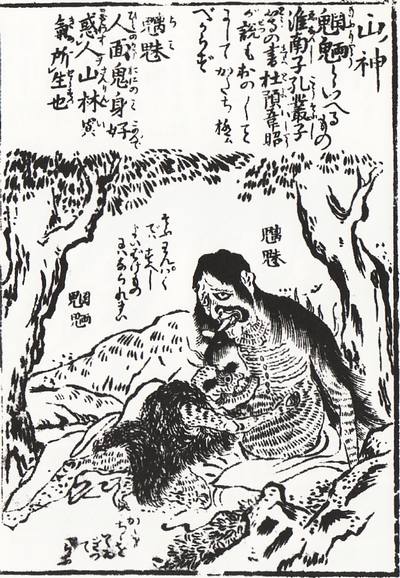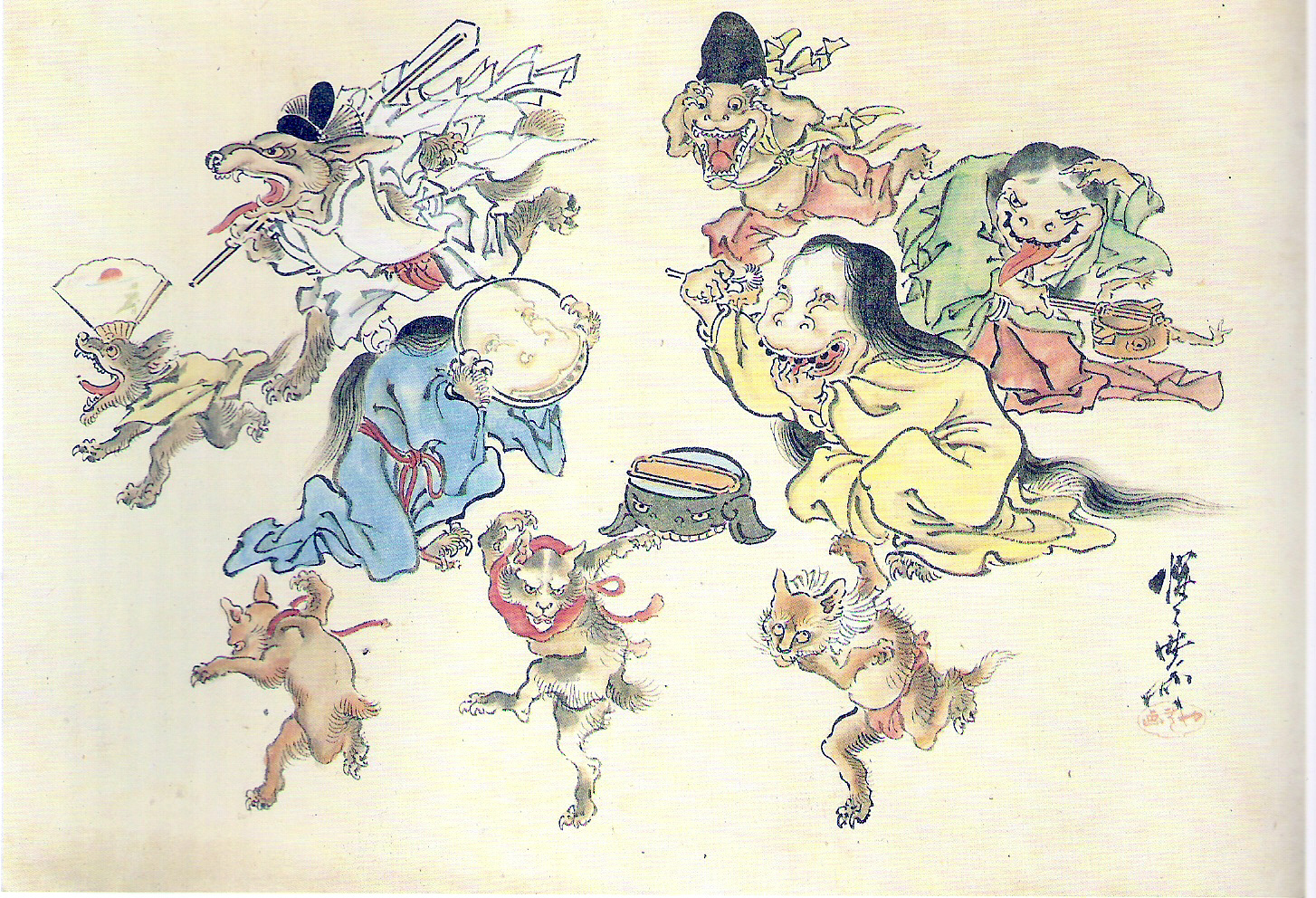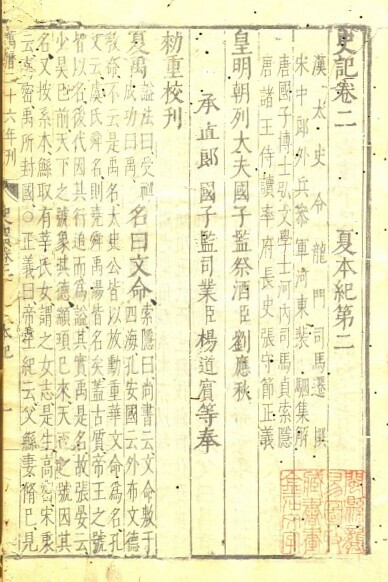|
Chimimōryō
Chimei wangliang, or Chimimōryō (), is a term that refers to monsters of the mountains and monsters of the rivers. The term originated in China roughly 2,500 years ago in ancient chronicles such as the ''Zuo Zhuan''. It originates from ancient Chinese legends about the spirits that harm people in the mountains and swamps, and its original meaning is "all kinds of Yaoguai (demons and ghosts)". Explanation Chimei Chimei ()(Chimi in Japanese) is also called Kui. Born from the strange atmosphere of the mountains and forests, they are spirits transformed from wood and stone. Characterized by a human face and an animal body with four legs, it is very charming. Wangliang Wangliang()(Mōryō in Japanese) are considered to be spirits from mountains and rivers, and trees and rocks. They emerge from the life energy of mountains, water, trees, rocks, and all natural things, and fool humans. They are also said to eat the dead, have the appearance of a child, stand on two feet, have dark ... [...More Info...] [...Related Items...] OR: [Wikipedia] [Google] [Baidu] |
Wangliang
In Chinese folklore, a ''wangliang'' ( zh, t=魍魎, p=wǎngliǎng or zh, t=罔兩) is a type of malevolent spirit. Interpretations of the ''wangliang'' include a wilderness spirit, similar to the '' kui'', a water spirit akin to the Chinese dragon, a fever demon like the , a graveyard ghost also called or , and a man-eating demon described as resembling a 3-year-old child with brown skin, red eyes, long ears, and beautiful hair. Name In modern Chinese usage, ''wangliang'' is usually written with radical-phonetic characters, combining the "ghost radical" (typically used to write words concerning ghosts, demons, etc.) with the phonetic elements and ) (lit. "deceive" and "two", respectively). In Warring States period (475–221 BC) usage, ''wangliang'' was also phonetically transcribed using the character pronunciations and , and written as with the " animal radical" (used to write names of insects, dragons, etc.) or ) using ; "dry moat") with the " gate radical" (typic ... [...More Info...] [...Related Items...] OR: [Wikipedia] [Google] [Baidu] |
Tsukumogami
In Japanese folklore, ''tsukumogami'' (付喪神 or つくも神, lit. "tool ''kami''") are tools that have acquired a kami or spirit. According to an annotated version of ''The Tales of Ise'' titled ''Ise Monogatari Shō'', there is a theory originally from the ''Onmyōki'' (陰陽記) that Foxes in Japanese folklore, foxes and Japanese raccoon dog, tanuki, among other beings, that have lived for at least a hundred years and changed forms are considered ''tsukumogami''. In modern times, the term can also be written 九十九神 (literally ninety-nine ''kami''), to emphasize the agedness. According to Komatsu Kazuhiko, the idea of a ''tsukumogami'' or a ''yōkai'' of tools spread mostly in the Japanese Middle Ages and declined in more recent generations. Komatsu infers that despite the depictions in Bakumatsu period ukiyo-e art leading to a resurfacing of the idea, these were all produced in an era cut off from any actual belief in the idea of ''tsukumogami''. Because the term ... [...More Info...] [...Related Items...] OR: [Wikipedia] [Google] [Baidu] |
Mononoke
are vengeful spirits (onryō), dead spirits (shiryō), live spirits (ikiryō), or spirits in Japanese classical literature and folk religion that were said to do things like possess individuals and make them suffer, cause disease, or even cause death. It is also a word sometimes used to refer to ''yōkai'' or ''henge'' ("changed beings"). Summary ''Mononoke'' can be often seen in literature of the Heian period. As a famous example, in the 9th volume of the ''The Tale of Genji, Genji Monogatari'', "Aoi" is the ikiryō of Lady Rokujo, who possessed Aoi no Ue. Other than that, there are also statements about ''mononoke'' in publications like ''Ōkagami'' and ''Masukagami''. In those times, when medical knowledge had not been fully developed, people like monks and Yamabushi, shugensha would perform incantations and prayers against diseases caused by ''mononoke'', and by temporarily moving the ''mononoke'' into a different person called the "Yorishiro, yorimashi" (usually servants, ... [...More Info...] [...Related Items...] OR: [Wikipedia] [Google] [Baidu] |
Hyakki Yagyō
''Hyakki Yagyō'' (, "Night Parade of One Hundred Demons"), also transliterated ''Hyakki Yakō'', is an idiom in Culture of Japan, Japanese folklore. Sometimes an orderly procession, other times a riot, it refers to a parade of thousands of supernatural creatures known as ''oni'' and ''yōkai'' that march through the streets of Japan at night. As a terrifying eruption of the supernatural into the real world, it is similar (though not precisely equivalent) to the concept of wikt:pandemonium, pandemonium in English. Various legends Over more than one thousand years of history, and its role as a popular theme in traditional storytelling and art, a great deal of folklore has developed around the concept, making it difficult if not impossible to isolate any canonical meanings. One legend of recent vintage states that "every year the ''yōkai'' Nurarihyon, will lead all of the ''yōkai'' through the streets of Japan during summer nights." Anyone who comes across the procession would ... [...More Info...] [...Related Items...] OR: [Wikipedia] [Google] [Baidu] |
Three Sovereigns And Five Emperors
According to Chinese mythology and traditional Chinese historiography, the Three Sovereigns and Five Emperors () were a series of sage Chinese emperors, and the first Emperors of China. Today, they are considered culture heroes, but they were widely worshipped as divine "ancestral spirits" in ancient times. According to received history, the period they existed in preceded the Xia dynasty, although they were thought to exist in later periods to an extent in incorporeal forms that aided the Chinese people, especially with the stories of Nüwa existing as a spirit in the Shang dynasty and Shennong being identified as the godly form of Hou Ji and a founder of the Zhou dynasty. In myth, the Three Sovereigns were demigods who used their abilities to help create mankind and impart to them essential skills and knowledge. The Five Emperors were exemplary sages who possessed great moral character, and were from a golden age when "communications between the human order and the divine ... [...More Info...] [...Related Items...] OR: [Wikipedia] [Google] [Baidu] |
Records Of The Grand Historian
The ''Shiji'', also known as ''Records of the Grand Historian'' or ''The Grand Scribe's Records'', is a Chinese historical text that is the first of the Twenty-Four Histories of imperial China. It was written during the late 2nd and early 1st centuries BC by the Han dynasty historian Sima Qian, building upon work begun by his father Sima Tan. The work covers a 2,500-year period from the age of the legendary Yellow Emperor to the reign of Emperor Wu of Han in the author's own time, and describes the world as it was known to the Chinese of the Western Han dynasty. The ''Shiji'' has been called a "foundational text in Chinese civilization". After Confucius and Qin Shi Huang, "Sima Qian was one of the creators of Imperial China, not least because by providing definitive biographies, he virtually created the two earlier figures." The ''Shiji'' set the model for all subsequent dynastic histories of China. In contrast to Western historiographical conventions, the ''Shiji'' does no ... [...More Info...] [...Related Items...] OR: [Wikipedia] [Google] [Baidu] |
Yama-no-Kami
Mountain Gods () are Asian tutelary deities associated with mountains. They are related to Landlord deity, landlord deities and tudigongs and City God (China), City Gods. They are well-known in Korea and some prominent Chinese mountains have shrines to similar deities in the Daoist traditions, called ''Shanshen''. The Japanese equivalent is the ''Yama-no-Kami'' (; also pronounced as ''yamagami'') and the Vietnamese equivalent is ). Houtu is the overlord of all the Tudigongs ("Lord of Local Land"), Soil and grain, Sheji ("the State"), Shan Shen ("God of Mountains"), City God (China), City Gods ("God of Local City"), and landlord gods worldwide. China In China, legends about ''Shanshen'' () have a long history. The Classic of Mountains and Seas (), which was written more than 2,000 years ago, has already recorded various legends about ''Shanshen''; specifically the Wuzang Shanjing () part contains a detailed description of the appearance of the mountain gods. The Taiping Guangji () ... [...More Info...] [...Related Items...] OR: [Wikipedia] [Google] [Baidu] |
Wakan Sansai Zue
The is an illustrated Japanese ''leishu'' encyclopedia published in 1712 in the Edo period. It consists of 105 volumes in 81 books. Its compiler was Terashima or Terajima Ryōan, Terajima (), a doctor from Osaka. It describes and illustrates various activities of daily life, such as carpentry and fishing, as well as plants and animals, and constellations. It depicts the people of "different/strange lands" (''ikoku'') and "outer barbarian peoples". Sources used As seen from the title of the book (Wa (Japan), wa , which means Japan, and Han dynasty, kan , which means China), Terajima's idea was based on a Chinese encyclopedia, specifically the Ming dynasty, Ming work ''Sancai Tuhui'' ("Pictorial..." or "Illustrated Compendium of the Three Powers") by Wang Qi (encyclopedist), Wang Qi (1607), known in Japan as the . Reproductions of the ''Wakan Sansai Zue'' are still in print in Japan. References External links Scansof the pages are available in thof the National Diet Libra ... [...More Info...] [...Related Items...] OR: [Wikipedia] [Google] [Baidu] |
Edo Period
The , also known as the , is the period between 1600 or 1603 and 1868 in the history of Japan, when the country was under the rule of the Tokugawa shogunate and some 300 regional ''daimyo'', or feudal lords. Emerging from the chaos of the Sengoku period, the Edo period was characterized by prolonged peace and stability, urbanization and economic growth, strict social order, Isolationism, isolationist foreign policies, and popular enjoyment of Japanese art, arts and Culture of Japan, culture. In 1600, Tokugawa Ieyasu prevailed at the Battle of Sekigahara and established hegemony over most of Japan, and in 1603 was given the title ''shogun'' by Emperor Go-Yōzei. Ieyasu resigned two years later in favor of his son Tokugawa Hidetada, Hidetada, but maintained power, and defeated the primary rival to his authority, Toyotomi Hideyori, at the Siege of Osaka in 1615 before his death the next year. Peace generally prevailed from this point on, making samurai largely redundant. Tokugawa sh ... [...More Info...] [...Related Items...] OR: [Wikipedia] [Google] [Baidu] |
Heian Period
The is the last division of classical Japanese history, running from 794 to 1185. It followed the Nara period, beginning when the 50th emperor, Emperor Kammu, moved the capital of Japan to Heian-kyō (modern Kyoto). means in Japanese. It is a period in Japanese history when the Chinese influence on Japanese culture, Chinese influences were in decline and the national culture matured. The Heian period is also considered the peak of the Japanese Emperors of Japan, imperial court, noted for its Japanese art, art, especially Japanese poetry, poetry and Japanese literature, literature. Two syllabaries unique to Japan, katakana and hiragana, emerged during this time. This gave rise to Japan's famous vernacular literature, with many of its texts written by court ladies who were not as educated in Chinese as their male counterparts. Although the Imperial House of Japan had power on the surface, the real power was in the hands of the Fujiwara clan, a powerful Kuge, aristocratic family wh ... [...More Info...] [...Related Items...] OR: [Wikipedia] [Google] [Baidu] |
Wamyō Ruijushō
The is a 938 CE Japanese dictionary of Chinese characters. Heian period scholar Minamoto no Shitagō (源順, 911–983 CE) began compilation in 934, at the request of Emperor Daigo's daughter. The title is abbreviated as , and is also spelled 倭名類聚抄 (with '' wa'' 倭 "dwarf; Japan" for ''wa'' 和 "harmony; Japan") and 倭名類聚鈔 (with ''shō'' 鈔 "copy; summarize" for ''shō'' 抄 "copy; annotate"). The ''Wamyō ruijushō'' is the oldest extant Japanese dictionary organized into semantic headings, analogous to a Western language thesaurus. This ancient lexicographical collation system was developed in Chinese dictionaries like the '' Erya'', '' Xiao Erya'', and '' Shiming''. The ''Wamyōshō'' categorizes ''kanji'' vocabulary, primarily nouns, into main headings (''bu'' 部) divided into subheadings (''rui'' 類). For instance, the ''tenchi'' (天地 "heaven and earth") heading includes eight semantic divisions like ''seishuku'' (星宿 "stars and conste ... [...More Info...] [...Related Items...] OR: [Wikipedia] [Google] [Baidu] |






